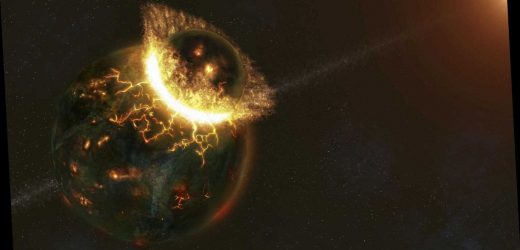In new research, scientists speculate that Earth was formed by a Mars-sized rogue planet known as Theia—with identifiable bits of the alien planet still found in Earth’s interior.
Scientists believe the same fateful impact also formed the moon, but this is the first time they’ve studied the specific traces of the clash that remain behind in the Earth’s mantle.
In 2016, UCLA researchers proposed that Earth could actually be two planets that fused together after colliding: itself and Theia. At the time, scientists said they believe the two planetary masses mixed together uniformly. Now, Qian Yuan of Arizona State University and his colleagues suggest the mysterious dense spots in Earth’s interior are the specific pieces of Theia that are still intact.
Yuan’s team presented a paper earlier this month at the 52nd Lunar and Planetary Science Conference. In it, they explain:
These dense areas are “continent-sized Large Low Shear Velocity provinces (LLSVPs).”
The Arizona State scientists identified specific portions of Earth’s interior and modeled the process by which these portions could have struck early Earth and sunk into its center:
In an interview with Vice, Yuan talked about getting a bolt of inspiration after chatting with a colleague about LLSVPs. “When I got back to my office,” Yuan said, “I just did a very easy calculation where I compared the size of the LLSVPs to the mantle of Mars, because Theia was believed to be very similar to Mars. The total mass of the moon, together with the LLSVPs, is almost perfectly matched with [Mars’s] mantle.”
How have the dense Theia materials stayed intact for billions of years? It’s a function of the way Earth’s mantle works, where convection circulates materials that are a certain temperature and density. The Theia materials are so dense that they sank and never floated back into the convection zone. Think of this like the stuff that accumulates in a sharp corner that’s hard to reach with the vacuum cleaner.
And what does it mean for these materials to stay deep inside Earth? The “continent-sized” areas are the largest portions of Earth’s interior, so understanding how they formed and how they persist could help push Earth science forward. These two huge portions are located under West Africa and the Pacific Ocean and are hundreds of miles thick, HuffPost explains.
There could also be interesting parallels to unearth, so to speak, between these dense mantle portions and the moon because of their potentially shared origin story. How often can you compare one 4.5-billion-year-old rock sample that’s orbited in space and another that’s sunk into the center of Earth? It’s a scientific method dream come true.
🎥 Now Watch This:
Source: Read Full Article


